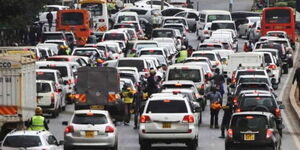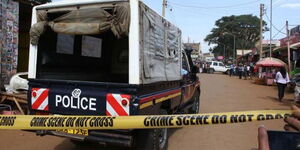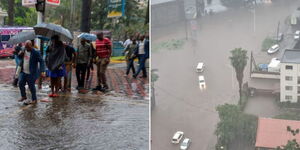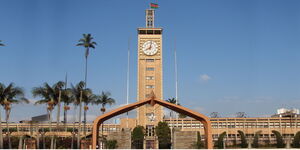When travelling through Nairobi's Central Business District (CBD), you will most likely use one of the popular matatu stages when getting on or off a matatu in the city centre.
From 'Commercial’, ‘Khoja’, ‘OTC’, ‘Ambassador’, 'Odeon' to ‘BS’, these stages mark the areas where passengers can board a matatu to other areas in Nairobi and its surrounding areas.
From Ngong, Lang’ata, Embakasi, Westlands, Juja to Thika, the stages act as important conduits in the city’s overall transport network.
However, these stages have interesting backstories, from being associated with famous banks and hotels, to just being within the vicinity of important buildings.
Commercial
‘Commercial’ stage is located at the intersection of Kenneth Matiba Road and Tom Mboya Street, behind the Kenya National Archives building.
Its history dates back to the early post-colonial era, stretching to the 1970s and 1980s. This is when the Kenya Bus Service (KBS) was the sole transport service in and around the city centre.
Back then, the building that currently houses the Kenya National Archives was the headquarters of the Kenya Commercial Bank. It was a vital stop for KBS, where passengers would alight at the central landmark.
So when passengers would want to alight in the city centre, they would request to be dropped at ‘Commercial’. The name stuck and is still used to this day.
Currently, matatus using the ‘Commercial’ stage mostly ply the Jogoo Road route as they go to Eastlands. This includes estates along Outering Road like New Donholm, Tassia, Fedha and Pipeline. The matatus also use Mombasa Road, where they connect to Jogoo Road through Cabanas and Outering Road.
OTC
Firstly, the abbreviation originated from the Overseas Trading Company (OTC), a London-based company that introduced public buses to the country for the first time. The company operated a fleet of 13 buses in Kenya from 1934 onwards. These buses ran on 12 routes in Nairobi, which formed the basis of the city’s transport network and are still in use today.
The buses also ferried customers across East African cities, including Dar-es-Salaam, Arusha, Kampala, and Jinja, Tanga, and Morogoro through other small towns.
The buses were staged along the famous Racecourse Road but the bus service collapsed in the late 1980s and other local investors took over the country’s transport sector.
While the OTC bus service collapsed, the stage is still very active, and is located near an "unfinished" 9-storey building along Ronald Ngala street just before the Racecourse Road intersection. However, the building has since been completed and is occupied by various businesses.
Matatus using this stage mostly ply the Thika Road route, transporting commuters to areas such as Githurai, Roysambu and Kahawa. Other matatus go to Eastlands, using Jogoo Road to access areas such as Kayole.
Ambassadeur
Another stage, Ambassadeur, was named after the historic Ambassadeur Hotel on Moi Avenue. The hotel has served as a prominent landmark and terminus for matatu routes heading to Nairobi's Eastlands area for a very long time.
Due to its central location within the CBD and ample parking space, the hotel’s entrance soon became synonymous with members of the public waiting to board buses home.
The building’s front also offered shelter to members of the public when it rained, and buses would come to pick up passengers from there. As a result, the hotel slowly established itself as a popular bus stage for Kenyans.
The stage serves matatus heading to areas such as Utawala, as well as those along Outering Road, including Pipeline, Fedha, Tassia and New Donholm. When buses use Mombasa Road, they can also stop at bus stops along the road until the City Cabanas area.
BS (Bus Station)
Another stage is the Bus Station (BS) stage, which is situated on Temple Road between Mfangano Street and Uyoma Street. Originally known as the Central Bus Station, it was for the longest time reserved for the exclusive use of the Kenya Bus Service.
The introduction of the Nyayo Bus Service in the mid-1980s, together with the emergence of 14-seater matatus, ended the long-running KBS monopoly. This ultimately culminated in the influx of different matatus at the stage.
Fast forward to today, matatus at this stage normally head towards the southern and western suburbs of the city including Makadara, Hurlingham, Lang’ata, South B, South C, and Nyayo Estate.
Odeon
Odeon, or Odeon Cinema, is a well-recognized landmark in Nairobi's Central Business District (CBD)as it conveniently serves as a transportation hub.
One can easily find transportation to various city routes, including destinations like Ruiru, Westlands, Kahawa West, Lavington, and even to neighbouring counties such as Kiambu.
Before it became a matatu stage, Odeon served as a cinema, first built in Kenya in the early 1950s. The first film screened at this cinema was the Drama/Romance film Anarkali, starring Pradeep Kumar, Bina Rai, and Mubarak Mechant.
Other stages in the capital include Khoja, Kencom, Muthurwa market, Afya center and Railways.












